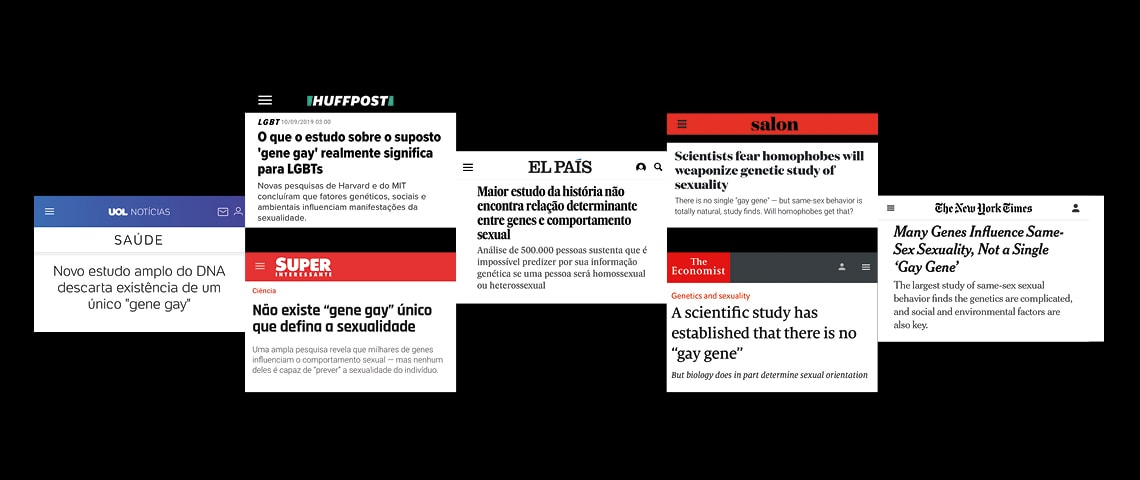A large-scale study on the genetic basis of same-sex sexual behavior, published last September in Science, has revealed thousands of genetic variants, and five chromosome regions, that are linked to same-sex sexual activity. These variants combined, however, explain only 8-25% of variation in sexual behavior, with the rest influenced by cultural and environmental factors. The study, authored by researchers at Broad Institute, of the Massachusetts Institute of Technology and Harvard, analyzed the genomes of 409,000 people who donated blood samples to the UK Biobank and 68,500 individuals registered at the US-based consumer-genetics company 23andMe. Subjects rated their sexual practices on a six-degree scale from predominantly homosexual to predominantly heterosexual. According to the study, this combined contribution to behavior from a large number of genetic variants is similar to that observed in complex traits like stature, suggesting that same-sex sexual behavior is a normal part of human variation. “There is no gay gene,” lead study author Andrea Ganna told Nature, adding that it is impossible to predict homosexuality from genetics.
Genetic influence on same-sex sexual behavior has been explored in prior research, but never with such a large amount of available data. The study is also notable for the authors’ uniquely cautious approach to reporting complex findings. The press release announcing the results contained a series of disclaimers about the limitations of the study: subjects were predominantly of European ancestry, so the results cannot be generalized to other ethnicities; the study is about behavior, not sexual orientation; and the boundaries of the study prevent conclusions from being drawn about other aspects of the complexity of human sexual behavior. The authors worked closely with science communication experts and gay, lesbian, bisexual, and transgender advocacy groups to discuss strategies for presenting the findings. This informed the content of a dedicated website (geneticsexbehavior.info) presenting the conclusions and rationale of the study in plain language and without jargon. On a separate website (bit.ly/SexualBehavior), the Broad Institute published 10 essays written by the authors and other experts to help frame the findings and provide an understanding of their impact and implications.
One author, Broad Institute geneticist Benjamin Neale, wrote about the team’s motivations and concerns. “The UK Biobank data were available for research through a controlled access process. This meant that it was inevitable someone would pursue studies of same-sex sexual behavior. With that in mind, I felt it was important to ensure that a diverse set of scientific perspectives, personal experience, and expertise were represented on our research team. Our team included experts in genetics, statistics, sexual behavior, and sociology.” Before designing the project, the authors conducted a series of outreach and engagement activities with LGBT alliance and advocacy groups to discuss the objectives and risks of the study. One of the concerns expressed by these groups was how these results might be twisted to support conversion therapy for homosexuals, a notion thoroughly debunked by science, or to promote the concept that people choose to be gay, lesbian or bisexual. “The analysis and results we present do not support and should not be used to bolster such arguments,” says Neale.
These concerns are not without foundation. In 1991, British neuroscientist Simon LeVay announced in an article in Science that he had found differences in the brain anatomy of gay and non-gay men—a specific region of the hypothalamus was two to three times larger in heterosexual men than in gay men. The evidence, while robust, was based on a group of gay men who had all died of AIDS, and LeVay had failed to consider whether this condition might have affected the results. LeVay, who is openly gay himself, argued at the time that because sexual orientation is hardwired, it is unreasonable to pressure people who are gay into changing their behavior. Two years later, Dean Hamer of the US National Cancer Institute identified a region of the X chromosome that was identical in brothers who were gay. These findings also lent themselves to twisted interpretations.
“Online comments and blog postings discussing LeVay’s article indicated that, by and large, it helped perpetuate the idea that homosexuality was a mental disorder,” explains Carino Gurjao, a bioinformatics analyst at the Broad Institute, in one of the essays contextualizing the findings from the new paper. Gurjao notes that the link between genetics and same-sex sexual behavior is very tenuous, and believes the data could be misinterpreted. “I worry that genetics will be the latest way to wrongly label and attribute traits to the LGBTQIA+ community. For example, the correlations between same-sex sexual behavior and number of sexual partners, depression, and drug use identified in Ganna et al. could be used to stigmatize LGBTQIA+ people.”
University of Oxford sociologist Melinda Mills, who reviewed the findings from Ganna et al.’s study in an essay in Science, says the paper provides clues that can guide future research on the subject. “Future work should investigate how genetic predispositions are altered by environmental factors, with this study highlighting the need for a multidisciplinary sociogenomic approach,” she writes.
Republish
